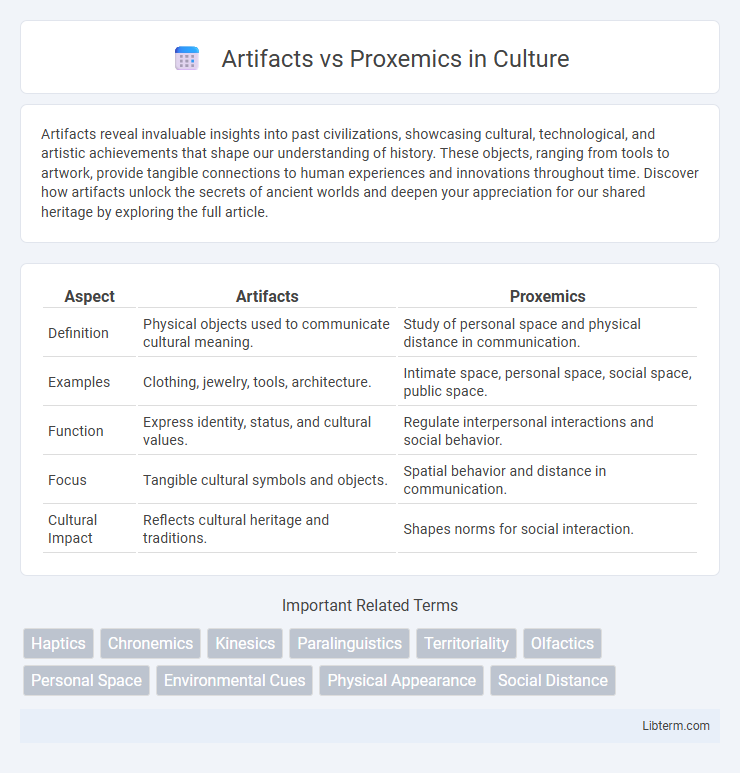Artifacts reveal invaluable insights into past civilizations, showcasing cultural, technological, and artistic achievements that shape our understanding of history. These objects, ranging from tools to artwork, provide tangible connections to human experiences and innovations throughout time. Discover how artifacts unlock the secrets of ancient worlds and deepen your appreciation for our shared heritage by exploring the full article.
Table of Comparison
| Aspect | Artifacts | Proxemics |
|---|---|---|
| Definition | Physical objects used to communicate cultural meaning. | Study of personal space and physical distance in communication. |
| Examples | Clothing, jewelry, tools, architecture. | Intimate space, personal space, social space, public space. |
| Function | Express identity, status, and cultural values. | Regulate interpersonal interactions and social behavior. |
| Focus | Tangible cultural symbols and objects. | Spatial behavior and distance in communication. |
| Cultural Impact | Reflects cultural heritage and traditions. | Shapes norms for social interaction. |
Understanding Artifacts and Proxemics
Artifacts, such as clothing, accessories, and personal belongings, serve as visual symbols that convey identity, status, and cultural meaning in social interactions. Proxemics studies the use of personal space and physical distance in communication, influencing how individuals perceive intimacy, authority, and social norms. Understanding artifacts and proxemics enhances the interpretation of nonverbal cues, facilitating effective interpersonal communication and cultural awareness.
Defining Artifacts in Communication
Artifacts in communication refer to the physical objects, clothing, and personal belongings that convey messages about identity, social status, and cultural affiliations without verbal interaction. These tangible items influence perceptions and interactions by signaling information about the communicator's personality, values, and group membership. Understanding artifacts helps decode nonverbal cues and enhances the effectiveness of interpersonal and intercultural communication.
The Role of Proxemics in Social Interaction
Proxemics governs the spatial relationships individuals maintain during social interactions, influencing communication effectiveness and comfort levels. Personal space distances vary culturally and situationally, shaping nonverbal cues that signal intimacy, authority, or social boundaries. Understanding proxemics enhances awareness of interpersonal dynamics, facilitating smoother interactions and reducing misunderstandings caused by unintentional spatial violations.
Artifacts: Tangible Symbols in Human Communication
Artifacts serve as tangible symbols in human communication, embodying cultural values, social status, and identity through physical objects like clothing, jewelry, and technology. These items convey implicit messages and facilitate nonverbal interaction by signaling personal or group affiliations, hierarchy, and emotional states. Understanding artifacts enhances awareness of how material culture shapes social dynamics and interpersonal relationships within various contexts.
Proxemics: The Language of Personal Space
Proxemics, the study of personal space, reveals how physical distance influences communication and social interactions across cultures. It categorizes spatial zones into intimate, personal, social, and public distances, each conveying different levels of comfort and relational dynamics. Understanding proxemics enables effective nonverbal communication by respecting boundaries and interpreting spatial cues accurately.
Cultural Influences on Artifacts and Proxemics
Cultural influences shape artifacts and proxemics by dictating the meanings, uses, and spatial behaviors embedded in everyday objects and interpersonal distances. Artifacts such as clothing, jewelry, and tools often symbolize cultural identity and social status, while proxemics governs the acceptable physical space during interactions, varying widely across cultures to reflect differing social norms and values. Understanding these cultural dimensions of artifacts and proxemics enhances cross-cultural communication and fosters greater cultural sensitivity.
Comparing Artifacts and Proxemics in Nonverbal Communication
Artifacts in nonverbal communication refer to physical objects like clothing, accessories, and personal belongings people use to express identity, status, and cultural affiliation, while proxemics focuses on the use of personal space and distance to convey intimacy, dominance, or social relationship. Artifacts communicate through tangible symbols that often carry cultural meanings, whereas proxemics operates through spatial behavior and physical positioning during interactions. Both elements are essential in decoding social cues, with artifacts providing visible markers and proxemics revealing subtle interpersonal dynamics.
Practical Examples of Artifacts and Proxemics
Artifacts such as clothing, jewelry, and personal gadgets serve as tangible indicators of identity and status, influencing first impressions in both social and professional settings. Proxemics, the study of personal space, determines comfort levels during interactions, with close distances signaling intimacy and wider gaps indicating formality or discomfort. For instance, in offices, personalized desks with artifacts convey authority, while maintaining appropriate proxemic distances fosters respectful communication between colleagues.
Impact of Technology on Artifacts and Proxemics
Technology has transformed artifacts by embedding digital capabilities into everyday objects, enhancing their functionality and communication roles within social interactions. Proxemics, or the study of personal space, is increasingly influenced by virtual environments and augmented reality, which redefine spatial boundaries and interpersonal distances. These technological advancements shift traditional artifact usage and proxemic behaviors, creating new norms in both physical and digital communication contexts.
Enhancing Communication Strategies: Integrating Artifacts and Proxemics
Enhancing communication strategies involves integrating artifacts and proxemics to create more impactful interactions by carefully considering the use of objects and spatial relationships. Artifacts such as personal items, clothing, and technology influence perceptions and convey nonverbal messages, while proxemics governs the physical distance and arrangement between communicators to optimize comfort and engagement. Combining these elements allows communicators to tailor environments and visual cues that reinforce intended messages, improve rapport, and increase clarity in both personal and professional settings.
Artifacts Infographic

 libterm.com
libterm.com